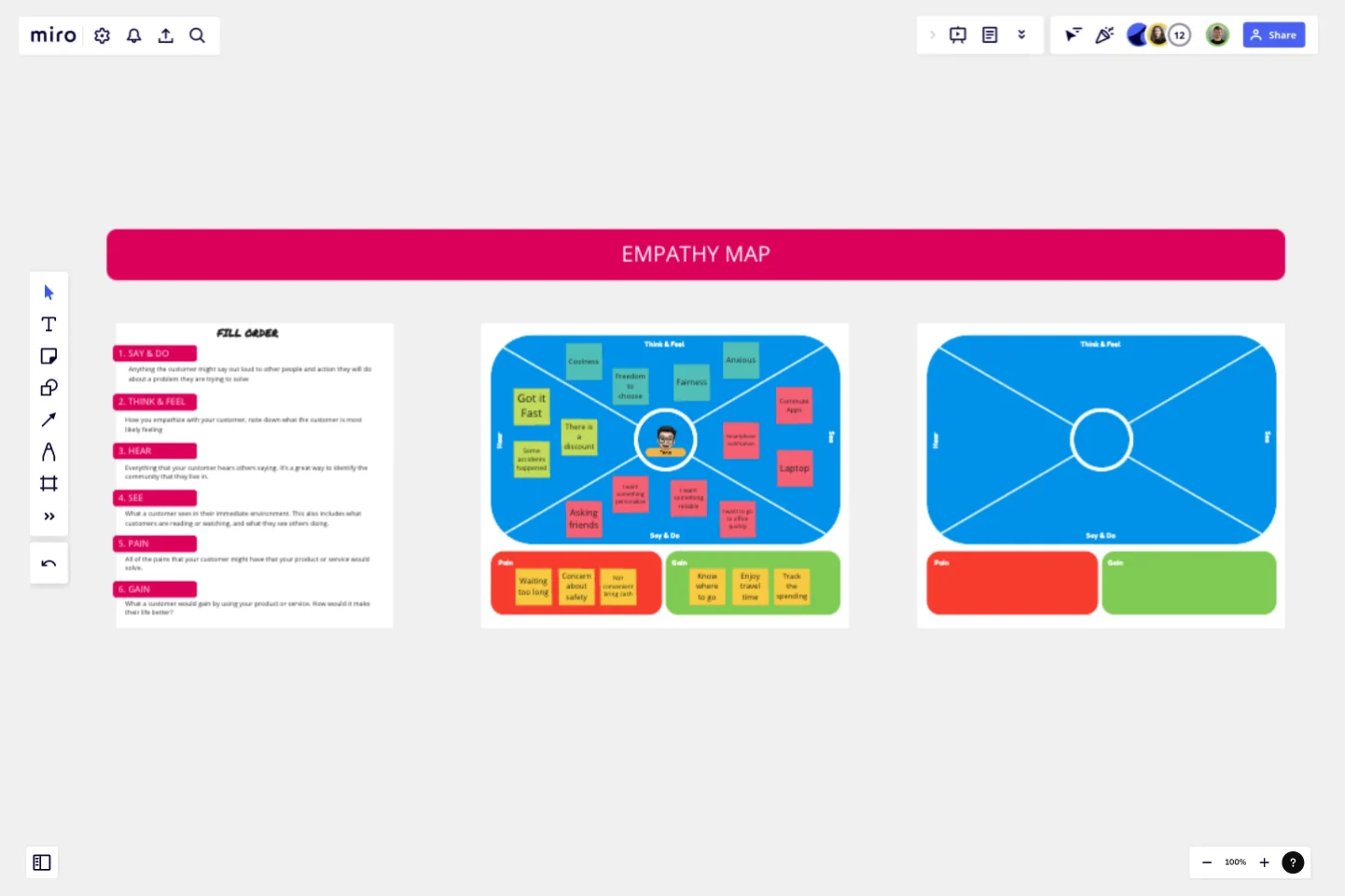Empathy Map Pro
Empathy maps are best used from the very beginning of the design process.
The mapping process can help synthesize research observations and reveal deeper insights about a user’s needs
Why Use Empathy Map?
Capture who a user or persona is. The empathy-mapping process helps distill and categorize your knowledge of the user into one place.
Communicate a user or persona to others: An empathy map is a quick, digestible way to illustrate user attitudes and behaviors. Once created, it should act as a source of truth throughout a project and protect it from bias or unfounded assumptions.
Collect data directly from the user. When empathy maps are filled in directly by users, they can act as a secondary data source and represent a starting point for a summary of the user session. Moreover, the interviewer may glean feelings and thoughts from the interviewee that otherwise would have remained hidden.
How does Empathy Map work?
Define the persona of target users and put into center of map, then fill all the 6 boxes accordingly.
Say & Do: Anything the customer might say out loud to other people and action they will do about a problem they are trying to solve.
Think & Feel: How you empathize with your customer, note down what the customer is most likely feeling.
Hear: Everything that your customer hears others saying. It’s a great way to identify the community that they live in.
See: What a customer sees in their immediate environment. This also includes what customers are reading or watching, and what they see others doing.
Pain: All of the pains that your customer might have that your product or service would solve.
Gain: What a customer would gain by using your product or service. How would it make their life better?
This template was created by Indra Kusuma.
Get started with this template right now.
Discovery Interviews Template
Works best for:
Design, UX
The Discovery Interviews Template is a powerful tool that allows you to delve into a topic from different angles and gain a deeper understanding of different perspectives. By conducting interviews using this template, you can uncover valuable insights and uncover new information that can help you make informed decisions. Whether you are a researcher, product manager, or simply curious about a specific topic, the Discovery Interviews Template is an essential resource for anyone looking to explore a subject in depth.
Empathy Map Canvas by Jack León
Works best for:
Research & Design, Market Research
Empathy Map Canvas is an essential tool for capturing user insights. By visualizing what users think, feel, and experience, you can create more effective and user-friendly designs. This template is perfect for teams focused on user-centered design.
Service Blueprint to connect journey & operations
Works best for:
Research & Design
Connect customer journeys with operational processes using the Service Blueprint by Essence. This template helps you map out service interactions and backend processes, ensuring seamless service delivery. Use it to align teams, identify gaps, and enhance the customer experience. Perfect for visualizing the entire service ecosystem and improving coordination between different service components.
Service Blueprint With AI
Works best for:
Research & Design
Integrate AI into your service design with the Service Blueprint With AI template. This tool helps you map out service processes and identify opportunities for AI enhancement. Use it to visualize interactions, streamline workflows, and improve customer experiences with AI-driven solutions. Perfect for teams looking to innovate and optimize services using advanced technology.
Service Blueprint by Slalom Philadelphia
Works best for:
Research & Design
The Service Blueprint by Slalom Philadelphia helps you map out service interactions and backstage processes. It's perfect for identifying service gaps and optimizing workflows. Use this template to align teams, improve customer experiences, and ensure seamless service delivery. It's ideal for fostering collaboration and strategic planning, making it a valuable tool for service design and improvement initiatives.
Service Blueprint to the Metaverse
Works best for:
Research & Design
Explore the future of service design with the Service Blueprint to the Metaverse. This template helps you map out service experiences within virtual environments. Use it to visualize interactions, identify opportunities, and plan seamless service delivery in the metaverse. Ideal for teams looking to innovate and expand their services into virtual and augmented reality spaces, enhancing customer engagement and satisfaction.
